Duo in glass
Summer exhibition att Vadstena Castle 2022
When Berit Johansson died in December 2021, Vadstena lost one of its greatest artists. An artistry with an international intensity and almost unreal and close proximity to the epicentre of glass art: Murano in Venice. Three years before that, her husband Jan Johansson passed away – also a glass artist who had resonated strongly around the art world. This year’s summer exhibition is a tribute from the town to its great designers, who have remained faithful to Vadstena despite their fame and success.
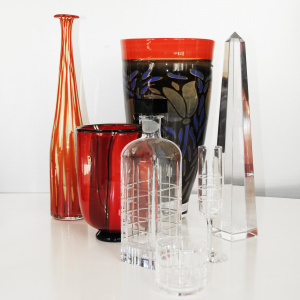
Engaging in glass art has both limits and freedoms. The material determines the limits, but it also allows for everything from strict lines to rounded shapes, from transparency to blazing colours, for both everyday life and special occasions. Over the years, Berit and Jan Johansson have used these expressions in many different ways. With the 2022 summer exhibition at Vadstena Castle, Vadstena wants to showcase selected works from the rich array of artistry that this ”duo in glass” stands for and humbly calls forth the greatness that this low-key artist duo has represented during their lifetime and still does.
Göran Fältgren
Chairman of the Culture and Education Committee in Vadstena
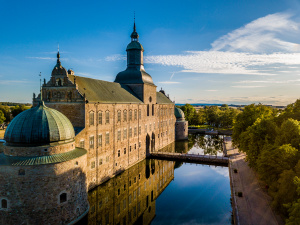
”DUO IN GLASS”
in the Little Hall of State at Vadstena Castle
Vadstena Castle is one of our country’s most magnificent Renaissance buildings, which got its appearance in the 16th and early 17th centuries during the regime of King Gustav Vasa and his sons. The originally reinforced defensive castle was transformed into a magnificent royal castle in the style of the time and was decorated as a representative residence of the royals. Much could be told about the fate of the castle in the centuries that followed. The ”modern” history of the castle, which extends into our own time, begins in 1899 with Landsarkivet, as a regional archival authority of the nationally covering National Archives, being given premises in the castle. They are still there today. Since 1935, the castle has been a listed building.
Gradually, the idea of showing the castle to visitors was raised. At the end of the 1960s, Vadstena Castle’s furniture foundation was formed with the task of recreating a timeless environment from the 17th century on the third floor, with the two national halls, the castle chapel and living and reception rooms in tune with the customs of the time. The result of the foundation’s many years of activity with purchases and placements of furniture, art and crafts predominantly from the 17th century is what brings the reception rooms to life today and gives us an idea of what they may once have looked like when the royals visited or when they stayed at the castle for longer periods.
It is in the shadow of this historically rich building that Berit Johansson, born in the town, and Jan Johansson, worked for many years in the studios that they set up in their house on Stora Torget. They both featured prominently on the world stage of glass art. It brought travel, work and exhibitions in Europe and on several other continents. It led to a large network, new impressions and inspiration for their creation. For Berit in particular, the environment in Vadstena and on the shores of Lake Vättern played a significant role. This is where she worked best.
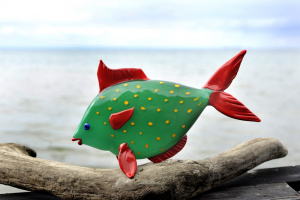
FOTO: GÖRAN BILLESON
When art glass by Berit Johansson and Jan Johansson is now shown in the memorial exhibition ”Duo in glass” in the Little Hall of State, it is a consciously selected location. Selected for its dialogue with history and the future. Gustav Vasa summoned glassblowers from Venice to Sweden in the 16th century. It is the beginning of our country’s long history of outstanding glass art. In the Little Hall of State, but also in an adjoining room, the walls are adorned with magnificent picture tapestries.
In the borders and motifs, there is a wealth of detail taken from the plant and animal kingdoms. Lush, playful and once colourful, now pale as a result of the test of time. Berit’s glass art is also magnificent. On the large table in the main hall, a modern table setting has been laid with Berit’s art glass, useful and bright, inspired by how magnificent and precious objects were displayed on tables laid in the 17th century.
Jan’s purest crystal constructive world of design, on some rare occasions in amber brown or green, makes us experience him as a sculptor in the rich constructive modernism of our own time. But also to associate his designs with the wealth of symmetry and clarity of form that characterises the Baroque gardens of the 17th-century. Vadstena Castle’s former garden was certainly much simpler but symmetrically planted.
With Vadstena as a base, Berit Johansson and Jan Johansson took their place on the world stage of glass art. In the Little Hall of State, an exclusive and sparse selection of their artistic creations are now on display.
Stefan Hammenbeck
Art historian, Östergötland Museums
member of the Furnishing Foundation 2008-2020
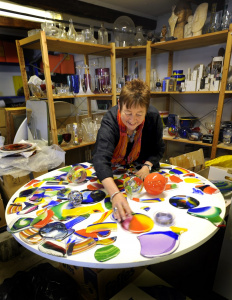
FOTO: GÖRAN BILLESON
Visit to the studio
In the pink 18th-century building on Bakgatan in Vadstena, Berit and Jan had their studio.
This is where they lived and worked for many years. In the court-yard building, they ran the company Art Design AB where there was a workshop, studio and showroom.
Jan’s work table was always filled with piles of sketches. This is where he developed his artistic ideas for glass, fabrics, cutlery and serving trays. For a few years, Jan was associated with Svensk Form i Kosta AB, a design company that operated in several areas under one umbrella organisation. He was fascinated by communicating with the artists, irrespective of whether they were in Orrefors or China. He was a technician who liked to solve problems. When he was commissioned to design textile patterns for Kosta linnewäfveri, he based it on one of his crystal bowls. He rendered the cut in the crystal using a computer into models for the jacquard loom.
Even in Berit’s study, there were sketches, but she drew them by hand, as glass designers have always done.
For Berit, Vadstena was her home, in more ways than one. She was born and grew up here. She dreamed of becoming an archaeologist, inspired by the excavations at the abbey, but ultimately chose the path of the silversmith. First an internship with the local goldsmith then as an apprentice with Hovjuvelerare Strömdahl in Stockholm and from there via Pernby painting school to the University of Arts, Crafts and Design (Konstfack) and studies in England, Italy and the USA.
Jan was born on the island of Lidingö. His father was the sculptor Helge Johansson and Jan grew up in an artistic circle around Arne Jones and Sven Palmqvist, among others. Palmqvist was the one who secured a world patent on the centrifugal glass that became so groundbreaking at Orrefors in the 1950s. He set a good example.
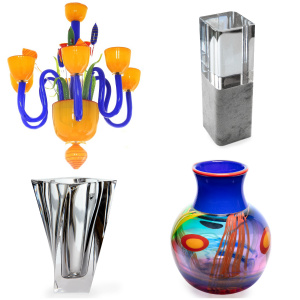
FOTO: JONAS SÄLLBERG OCH GÖRAN BILLESON
For Jan, the path to Konstfack became quite natural at the same time as he was fascinated by the technique. He trained to become a silversmith. One day he was summoned to Konstfack’s Vice-Chancellor. You must come to Orrefors, the order read. Jan heeded. Silver became glass.
They met at Konstfack and Berit went with Jan to Orrefors, first as a silversmith then later as a glass designer. For Jan, Orrefors and the classic crystal became his home and continued to be so for many years, but Berit felt that Orrefors became too limiting. She wanted to venture out and try her wings, she often quoted William Blake: ”No bird flies too high if it flies with its own wings”. As early as the 1980s she started making studio glass at Ulf Johansson’s studio in Sjöhyttan, and during most of the 1990s, she was associated as a designer with Salviati in Venice, and from 1998 with the family business Pauly C.V.M., also in Venice. It meant a lot of work, a lot of travel, but also a lot of freedom. She was tired of the forests of Småland and longed to return to the plains and Östergötland.
Berit and Jan purchased the pink house on Bakgatan, and started the joint venture Art Designs AB, both being based in Vadstena. From here the roads lead out: to Orrefors, Italy, India and China. The Art-Glass Exchange with Swedish and Indian designers took them to India and was enriching for both of them. Jan was however always ”Orreforian” in terms of his expression. ”The colour is in the pure crystal,” he said. His first sculpture, ”Metropolis” from 1973, captures the full spectrum of light in its prism while Berit’s bowls and sculptures in grail technique flare with colour.
It was the opposites that attracted. It was what set the two of them free.
Inga Wallenquist, 2006
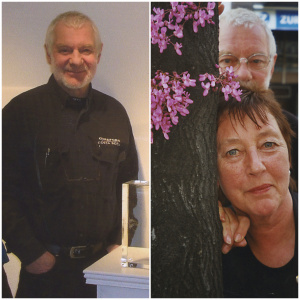
With Vadstena as a base, they took their place on the world stage of glass art.
Berit with her art glass not infrequently inspired by the animal and plant kingdoms but also by the world of design of household glassware, playful and pleasurable in colour, magnificent in a modern Baroque art tradition.
Jan with his highly polished art glass was creative in thought and design and with a luminosity in the purity of glass that fascinated the entire world. Jan even shaped a utility object into a sculpture.
Berit Johansson
Berit Johansson (1945 – 2021) glass artist and designer, educated at Åke Pernbys
Konstskola, Konstfack in Stockholm. She has also studied in England, Italy and
the USA. She worked for Orrefors glassworks from 1969 to 1983. Berit collaborated
with Sjöhyttan in Älghult, Småland and with Micke Johansson at Pukebergs
glassworks in Nybro, the master glassblower Ulf Johansson at Målerås glassworks
and with the ceramicist and designer Lasse Frisk and others. In 1985, Berit and Jan
started the joint company Art Design AB. For more than twenty years she worked at
the prominent glass houses in Murano, Venice with master glassblower (Silvano Signoretto)
Venini, Vetreria Signoretto & Bastianello Glassfactory, Salviati, and Pauly
CVM in Murano, Venice. Represented: at among others, the Corning Museum of
Glass, N.Y. State, USA, Röhsska Museum in Gothenburg, Smålands Museum, Sveriges
Glasmuseum, Växjö. Östergötland County Museum, Linköping, the Swedish
Embassy, New Delhi India. Pauly CVM Palace, San Marco Venice.
Jan Johansson
Jan Johansson (1942–2018) silversmith and glass designer, educated at Konstfack in
Stockholm. Johansson started as a designer at AGA in Stockholm and came to Orrefors
in 1969, where he designed bowls, vases, candlesticks and sculptures. In 1985,
Berit and Jan started the joint company Art Design AB. His work is associated with
stylish shapes and polished crystal that combine a contemporary design language
with a sense of tradition. Jan’s artistry can be seen in, among other places, Linköping
Cathedral and Vadstena Abbey Church. He is also represented in the National Museum
in Stockholm, Kunstindustrimuséet in Oslo, the Corning Museum of Glass in
the USA and the Museum of Kunst und Gewerbe in Hamburg. Today, the bar series
Street, launched in 2006, is available in the Orrefors range.